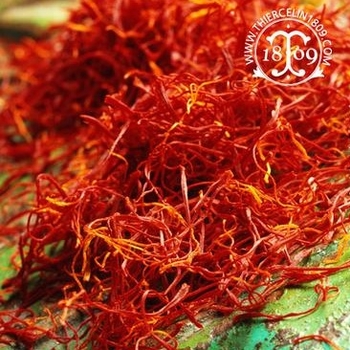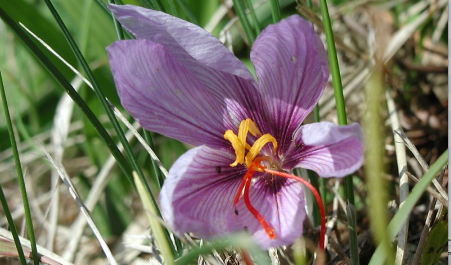Product
overview: Saffron
Saffron - the world's most valuable spice
"Saffron is very old, very expensive, almost mythical," says Jean-Marie Thiercelin, sixth of seven generations that have been buying, selling and packaging saffron for over two centuries. In ancient times, saffron was said "to serve the taste, please the eye and nourish the spirit."
Mentioned by the Chinese as a medicinal plant in 2200 BC, cited in the Bible's Garden of Eden (Song of Songs), referenced in Pliny's "Natural History," and depicted in the 16th c. BC frescos of the Palace of Minos at Knossos (Isle of Crete), saffron continued to be celebrated into the Middle Ages for its digestive properties and remains irreplaceable in contemporary non-Western medicine. Used sparingly, saffron accelerates the heart rate, warms the body, relieves pains, relaxes the nerves and promotes vitality.
The noblest of spices can fetch up to €30,000 per kilo. The reason for this price? Each tiny crocus flower must be harvested by hand, and 1 kilo of precious pistils requires some 200,000 flowers. Knowing it takes one hour to separate 1000 flowers, and 20 people to harvest one hectare, the calculation can be made quickly.
Avoiding fraud
Due to its myth and price, saffron "has always been adulterated, by any means possible." To counter fraud, Jean-Marie continues the with same philosophy of his ancestors - "to speak knowledgeably about the product, one needs to know everything there is to know about it. This means knowing everything there is to know about places from where the saffron comes, the composition of the agricultural infrastructure, and working personally with farmers to establish long-term relationships with them." For well over a decade, the family has owned a small farm 150 miles south of the shrine city of Mashhad in Iranian province of Khorassan - home of the poet Omar Khayyam - where most of the world's saffron is grown.Since 1809, Thiercelin's name and experience have guaranteed the highest purity and quality saffron. La Belle Safranière® is available in limited quantities, selected from the finest flowers of Crocus sativus L. in controlled plantations and graded according to ISO 3632, a standard developed on the basis of the Thiercelin family's expertise.
Saffron is characterized by the fact that it brings color, flavor and aroma - which one should see (and touch), smell and taste.
SEE: The physical appearance of the saffron stigmas already says a lot about the quality. There should be no foreign matter and a uniform color. The picture above gives a good illustration of beautiful saffron. For powder, uniform particle size, fine and smooth, with a deep orange color indicate quality product. If the powder is very dark red to brown, there is a risk of quality defects. Testing in a glass of warm water is still valid. Placing either a filament or a little powder on the water's surface, the sample should not fall to the bottom or leave red marks. Saffron colors are neither red nor yellow, but orange-yellow; more or less intense depending on quantity.
SMELL: Saffron must express its strong natural scent, a characteristic spicy, warm, woody and animal aroma with notes somewhat reminiscent of leather. Odorless saffron crocus is either of poor quality or adulterated.
TASTE: Should be slightly bittersweet, with a hint of astringency developing in the mouth. Over time the bitterness persists with intense licorice and oak flavor, and on the tip of the tongue, a spicy note.
Use of saffron
Most of the pigments in saffron are more soluble in water than in oils or fats, so rehydration in warm water prior to use in cooking will aid uniform dispersion of color.
However, note that the aromatic fraction of the spice is an essential oil practically insoluble in water, rather in fats or alcohol solvents. Furthermore, boiling saffron in a reduction sauce removes most of its flavor.
Saffron is used delicately as a spice. Indeed, dosage depends greatly on the quality of saffron used. Indeed, just one tenth of a gram of good saffron will get an excellent result. 125 mg saffron is enough for a family meal of 4 to 6 people. If too high a dose, the spice is dominated by notes of leather, wood and licorice.
Saffron is the essential spice for fish recipes (soups and soup), shellfish, risotto, rice and many desserts (cream and various pastries). Saffron goes well with pepper, cardamom, red fruit, white chocolate, vanilla. Classic saffron recipes include Indian byriani, Moroccan chermoula, Valencian paella, Catalan zarzuela, French bouillabaisse and risotto milanese. But it is a spice that must be savoured.
An interesting pairing of foie gras sprinkled with saffron stigma and a mild saffron syrup, reveals the bewitching power of these mythical threads.
Risotto Milanese
Serves 6400 g Carnaroli or Arborio rice
saffron powder or filaments
3 c. tablespoons olive oil
1 onion
1 L chicken stock
white wine 10 cl
50 g butter
100 g of parmesan
Heat the chicken broth over low heat 20 minutes, add the saffron. Cut the onion into small dice. In a skillet, sauté with olive oil, add the rice. When the grains are translucent, add the white wine and chicken broth.
Cover and cook 20 minutes over low heat. When the broth is completely absorbed by the rice, remove from heat and add the diced butter while stirring. Add the parmesan continuing to stir. Serve hot.
Source
La Belle Safranière® is graded ISO 3632 Category I, highest quality. Available in two forms, powder for optimum diffusion in dishes, or threads to remain visible in gastronomic preparations.

Alvinci Partners Kft. | H-1055 Budapest Markó utca 7. I/4b. | +36
1 783 2040 | info@alvincipartners.hu

